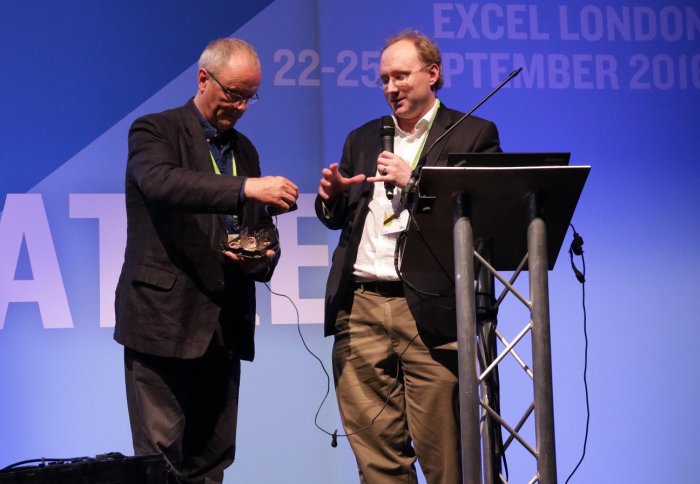Electric cars: live and unplugged
by Jane Horrell

Paul Mitcheson (r) with Robert Llewellyn and IGBT module: a transistor which can create high frequency AC power for wireless charging.
Paul Mitcheson leads the charge for wireless power at New Scientist Live
Electric vehicles are expected to become an important form of road transport in the coming decades; but how do they work, how will we charge them and what will they cost?
These were the questions raised in a panel discussion at the first New Scientist Live event – a major four-day festival of science, technology and engineering at the ExCeL exhibition centre in London last weekend.
An audience of around 450 festival visitors watched the event featuring Professor Paul Mitcheson of our Wireless Power Lab, who joined Red Dwarf actor and technology presenter Robert Llewellyn – a self-declared nerd and huge electric car fan - for a talk on vehicles of the future. The discussion featured demonstrations of the principal technologies, and Paul was also joined by Professors Mark Johnson and Jon Clare of the University of Nottingham, and electric motorcycle racer Jeremiah Johnson.
Paul and his research team have demonstrated significant increases in power density in comparison with commercially available inductive power transfer systems, and are pioneers in the field of large separation links. The technologies being developed at the Lab are envisaged to be used in electric vehicle charging, and in diverse applications including biomedical devices, and powering remote sensor networks.
Charging without the need to connect via a power cord is one of the main challenges in making electric vehicles feasible. Paul explains, “The future of electric mobility needs us to consider how a large electrified fleet of vehicles would interact with the electricity grid, and how they can be configured with greater range to reduce driver ‘range anxiety’. Wireless charging can help solve these problems.”
Car hire services, delivery vehicles, and taxis all are required to be on the road for more of the time than today’s private vehicles, so being able to take every opportunity to get some charge, even during brief stops, is where wireless charging really comes into its own.
As well as providing remote charging, this wireless power technology could also help to deliver autonomous transport systems in the future. Self-driving vehicles, such as taxis, and delivery vehicles - including drones, are already in development. As for the potential of the driverless private car, Paul says, “While I enjoy driving - outside of London, wireless charging will be required to support fully automated e-mobility systems of the future, at which point the act of a person driving a car will be reserved for the race track.”
Article text (excluding photos or graphics) © Imperial College London.
Photos and graphics subject to third party copyright used with permission or © Imperial College London.
Reporter
Jane Horrell
Department of Electrical and Electronic Engineering